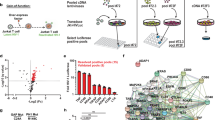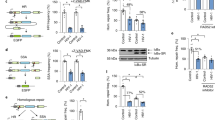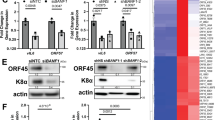Abstract
The human immunodeficiency virus, HIV (formerly T-cell lym-photropic virus type III, HTLV-III or lymphadenopathy-associated virus, LAV) is the primary cause of AIDS (acquired immune deficiency syndrome)'2. Patients with AIDS have profound immunosuppression as a result of almost complete absence of the OKT4+ cell population1,3 and are predisposed to a number of opportunistic infections as well as to certain malignant diseases such as Kaposi's sarcoma and B-cell tumours4,5. The majority of the opportunistic infections observed in AIDS patients are from the herpesvirus group6–8 and these are frequently the cause of death in AIDS patients. We have therefore investigated the effect of herpes virus infection on the expression of HIV and we provide evidence that herpes simplex virus type I (HSV-I) can reactivate transcription of latent HIV. In OKT4+ human T-cells HIV replicates to high virus titres, resulting in high level expression of viral RNA. This high level of expression has been attributed to virus-associated trans-acting factors that increase gene expression, directed by the HIV long terminal repeats (LTR)9, post-transcriptionally. In our studies we have tested whether transcription directed by the LTR of HIV is stimulated by HSV-I.
This is a preview of subscription content, access via your institution
Access options
Subscribe to this journal
Receive 51 print issues and online access
$199.00 per year
only $3.90 per issue
Buy this article
- Purchase on SpringerLink
- Instant access to full article PDF
Prices may be subject to local taxes which are calculated during checkout
Similar content being viewed by others
References
Popovic, M., Sarngadharan, M. G., Read, E. & Gallo, R. C. Science 224, 497–500 (1984).
Barre-Sinoussi, F. et al. Science 220, 868–871 (1983).
Edwards, K. M., Cooper, M. D., Lawton, A. R., Sanders, D. S. & Wright, P. F. J. Pediat. 105, 70–72 (1984).
Rapp, F. J. natn. Cancer Inst. 72, 783–787 (1984).
Friedman-Kien, A. E. et al. Ann. Intern. Med. 96, 693–700 (1982).
Hirsch, M. S. & Felsenstein, D. Ann. N.Y. Acad. Sci. 437, 8–15 (1984).
Spector, S. A., Hirata, K. K. & Neuman, T. R. J. infect. Dis. 150, 953–956 (1984).
Quinna, G. V. et al. J. Am. Med. Ass. 252, 72–77 (1984).
Rosen, C. A. et al. Nature 319, 555–559 (1986).
Sodroski, S. et al. Science 227, 171–173 (1985).
Sodroski, J. G., Rosen, C. A. & Haseltine, W. A. Science 225, 381–385 (1984).
Rosen, C. A., Sodroski, J. G. & Haseltine, W. A. Proc. natn. Acad. Sci. U.S.A 82, 6502–6506 (1985).
Mosca, J. D., Reyes, G. R., Pitha, P. M. & Hayward, G. S. J. Virol 56, 867–878 (1985).
Mantei, N., Boll, W. & Weissmann, C. Nature 281, 40–46 (1979).
Mosca, J. D. et al. (in preparation).
Batterson, W., Furlong, D. & Roizman, B. J. Virol 45, 397–407 (1983).
Campbell, M. E. M., Palfreyman, J. W. & Preston, C. W. J. molec. Biol. 180, 1–19 (1985).
Blattner, W. A., Biggar, R. J., Weiss, S. H., Melbye, M. & Goedert, J. J. Ann. intern. Med. 103, 665–669 (1985).
Dalgleish, A. G. et al. Nature 312, 763–766 (1984).
Montagnier, L. et al. Science 225, 63–66 (1984).
Koenig, S. et al. Science 233, 1089–1093 (1986).
Wiley, C. A., Schrier, R. D., Nelson, J. A., Lampert, P. W. & Oldstone, M. B. A. Proc. natn. Acad. Sci. U.S.A. 83, 7089–7093 (1986).
Kirchner, H. Monogr. Virol. 13, 1–104 (1982).
Chirgwin, J. M., Przybyla, A. E., MacDonald, R. J. & Rutter, W. J. Biochemistry 18, 5294–5299 (1979).
Melton, D. A., Krieg, P. A., Rebayliati, M. R., Maniatis, T., Zinn, K. & Green, M. R. Nucleic Acids Res. 12, 7035–7056 (1984).
Raj, N. B. K. & Pitha, P. M. Proc. natn. Acad. Sci. U.S.A. 80, 3923–3927 (1983).
Author information
Authors and Affiliations
Rights and permissions
About this article
Cite this article
Mosca, J., Bednarik, D., Raj, N. et al. Herpes simplex virus type-1 can reactivate transcription of latent human immunodeficiency virus. Nature 325, 67–70 (1987). https://doi.org/10.1038/325067a0
Received:
Accepted:
Issue Date:
DOI: https://doi.org/10.1038/325067a0
This article is cited by
-
Update in HIV Medicine for the Generalist
Journal of General Internal Medicine (2011)
-
Can herpes simplex virus type 2 suppression slow HIV disease progression: a study protocol for the VALacyclovir In Delaying Antiretroviral Treatment Entry (VALIDATE) trial
Trials (2010)
-
New insights on interactions between HIV-1 and HSV-2
Current Infectious Disease Reports (2009)
-
Acyclovir treatment of relapsing-remitting multiple sclerosis
Journal of Neurology (1996)
-
Transgenic and knockout mice in the study of neurodegenerative diseases
Journal of Molecular Medicine (1996)



